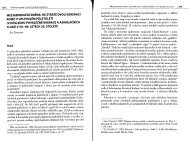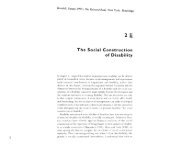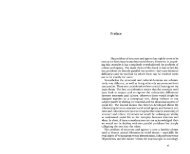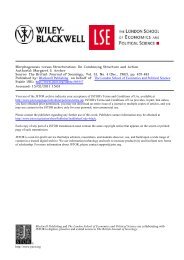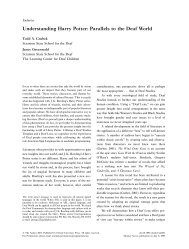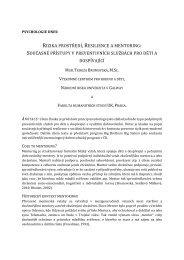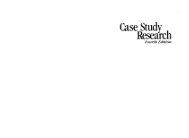Culture and Practical Reason Two Paradigms of ... - Moodle
Culture and Practical Reason Two Paradigms of ... - Moodle
Culture and Practical Reason Two Paradigms of ... - Moodle
- No tags were found...
You also want an ePaper? Increase the reach of your titles
YUMPU automatically turns print PDFs into web optimized ePapers that Google loves.
Chapter <strong>Two</strong> 116 <strong>Culture</strong> <strong>and</strong> <strong>Practical</strong> <strong>Reason</strong><strong>Two</strong> <strong>Paradigms</strong> <strong>of</strong> Anthropological Theory117Durkheim formulated a sociological theory <strong>of</strong> symbolization, but not asymbolic theory <strong>of</strong> society 0 Society was not seen as constituted by thesymbolic process; rather, the reverse alone appeared true. What then <strong>of</strong> theunderpinning <strong>of</strong> the categories, society itself? The problem <strong>of</strong> its naturebecame particularly acute on the epistemological level, for Durkheim hadto face the question <strong>of</strong> how categories derived from a particular socialformation could prove adequate to underst<strong>and</strong>ing the world. The answer inone sense was highly satisfactory, as it reconciled (tout a coup) all theparadoxes <strong>of</strong> Durkheim's superorganicism-by combining them, as itwere, into a superparadox that future generations would have to wrestlewith. The answer to how categories modeled on society could apply tonature was that society itself was natural:But if the categories originally only translate social states, does itnot follow that they can be applied to the rest <strong>of</strong> nature only asmetaphors? ...But when we interpret a sociological theory <strong>of</strong> knowledge in thisway, we forget that even if society is a specific reality it is not anempire within an empire; it is a part <strong>of</strong> nature, <strong>and</strong> indeed its highestrepresentation. The social realm is a natural realm which differs fromthe others only by a greater complexity.... That is why ideas whichhave been elaborated on the model <strong>of</strong> social things can aid us in thinking<strong>of</strong> another department <strong>of</strong> nature [note the exact inverse <strong>of</strong> LeviStrauss's idea <strong>of</strong> "the so-called totemism"). It is at least true that ifthese ideas play the role <strong>of</strong> symbols when they are thus turned asidefrom their original signification, they are well-founded symbols. If asort <strong>of</strong> artificiality enters into them from the mere fact they are constructedconcepts, it is an artificiality which follows nature veryclosely <strong>and</strong> which is constantly approaching it still more closely.[Durkheim 1947 (1912), ppo 18-19JIt is not important to dwell on this recuperation <strong>of</strong> soci~ty by nature, orthe naturalization <strong>of</strong> the sign <strong>and</strong> the other contradictions to his own bestsociological underst<strong>and</strong>ing that Durkheim presents here. Suffice it to indicatecertain consequences <strong>of</strong> the distinction between social structure <strong>and</strong>wrote: "II semble manifeste au contraire, au point qu'on ose apeine Ie faire remarquer,que la simple existence de ceremonies ou de travaux reguliers, que la simple distinctiondes clans et des tribus et de leur place respective dans Ie camp, presupposent lescategories logiques et ne sont possibles que grace aI'intervention prealable des idees detemps, d'espace, de causalite" (1919, p. 155n). I should like to thank M. Mark FrancilIon for drawing. my attention to this passage <strong>and</strong> work.mental concept as realized in a later anthropology. For the same incompleteappreciation <strong>of</strong> the symbol, that is, as merely the representation <strong>of</strong>social realities, continues to haunt the structural-functionalism developedby Radcliffe-Brown <strong>and</strong> others on a Durkheimian base. 44 The "symbolic"has been for the most part taken in the secondary <strong>and</strong> derivative sense <strong>of</strong> anideal modality <strong>of</strong> the social fact, an articulate expression <strong>of</strong> society, havingthe function <strong>of</strong> support for relationships themselves formed by realpoliticalor real-economic processes. Thus incorporated in the receiveddualism, the symbolic order becomes the ideology <strong>of</strong> social relations ratherthan their quality. The same effect is given by the arbitrary differentiation<strong>of</strong> "culture" from "social system" in the British school, as if socialrelations were not also composed <strong>and</strong> organized by meaning. Indeed, to theextent that meaning is taken as the mere" cultural content" <strong>of</strong>relationshipswhose formal structure is the true concern, the symbolic is merely a variableor accidental condition <strong>of</strong> the anthropological object instead <strong>of</strong> itsdefining property. Even the most valuable work on the conceptualization <strong>of</strong>. nature, Mary Douglas's, for example, is inclined to trade <strong>of</strong>f the semanticvalue <strong>of</strong> the categories for their social effects. More precisely, the onetends to be identified with the other-meaningful content with social value(in Radcliffe-Brown's sense)-by a tradition that "takes for granted thathuman thought serves human interests <strong>and</strong> therefore carries in itself at anygiven moment the social configurations <strong>of</strong> that time <strong>and</strong> place" (Douglas1973b, p. II). The effect is a one-sided view <strong>of</strong> meaning as social diacritics,<strong>and</strong> <strong>of</strong> the total cultural order as a utilitarian project.Acknowledging the epistemological doctrines <strong>of</strong>The Elementary Forms44. In a quasi- Whorfian way, Jameson accounts for the representational reflex in AngloAmerican social science by the preference for the term "symbol" as opposed to theFrench use <strong>of</strong> "sign" <strong>and</strong> the corollary tendency to relate terms to other terms in asemiotic system whose principles <strong>of</strong>differentiation would thus order objective reference.The difference <strong>of</strong> analytic predilections does seem real, even if the explanation is notentirely convincing (given normal French usage <strong>of</strong> signe): "the force <strong>of</strong> the AngloAmerican terminology, <strong>of</strong> the word 'symbol,' was to direct our attention towards therelationship between words <strong>and</strong> their objects or referents in the real world. Indeed, thevery word 'symbol' implies that the relationship between word <strong>and</strong> thing is not anarbitrary one at all, that there is some basic fitness in the initial association 0 It follows thatfor such a viewpoint the most basic task <strong>of</strong> linguistic investigation consists in a one-toone,sentence-by-sentence search for referents 0 0 0 • Saussure, on the other h<strong>and</strong>, isdeflected by his very terminology from the whole question <strong>of</strong>the ultimate referents <strong>of</strong>thelinguistic sign. The lines <strong>of</strong> flight <strong>of</strong> his system are lateral, from one sign to another,rather than frontal, from word to thing. a movement already absorbed <strong>and</strong> interiorized inthe sign itself as the movement from the signifier to the signified" (Jameson 1972, ppo31-32).



